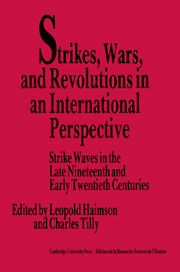 Strikes, Wars, and Revolutions in an International Perspective
Strikes, Wars, and Revolutions in an International Perspective Book contents
- Frontmatter
- Contents
- List of contributors
- Preface
- Part I Introductions
- Part II Models and realities
- Part III Workers in metal-processing enterprises in comparative perspective
- 11 From the mechanic to the metallo
- 12 Strikes of machinists in the United States, 1870–1922
- 13 The political economy of British engineering workers during the First World War
- 14 The rationalization of class struggle: strikes and strike strategy of the German Metalworkers' Union, 1891–1922
- 15 Scientific management and the changing nature of work in the St. Petersburg metalworking industry, 1900–1914
- 16 Structural processes of change and changing patterns of labor unrest: the case of the metal-processing industry in Imperial Russia, 1890–1914
- 17 Social characteristics, attitudes, and patterns of strike behavior of metalworkers in Italy during the First World War
- Part IV The effects of short-term variation
- Part V Conclusion
13 - The political economy of British engineering workers during the First World War
Published online by Cambridge University Press: 25 March 2010
- Frontmatter
- Contents
- List of contributors
- Preface
- Part I Introductions
- Part II Models and realities
- Part III Workers in metal-processing enterprises in comparative perspective
- 11 From the mechanic to the metallo
- 12 Strikes of machinists in the United States, 1870–1922
- 13 The political economy of British engineering workers during the First World War
- 14 The rationalization of class struggle: strikes and strike strategy of the German Metalworkers' Union, 1891–1922
- 15 Scientific management and the changing nature of work in the St. Petersburg metalworking industry, 1900–1914
- 16 Structural processes of change and changing patterns of labor unrest: the case of the metal-processing industry in Imperial Russia, 1890–1914
- 17 Social characteristics, attitudes, and patterns of strike behavior of metalworkers in Italy during the First World War
- Part IV The effects of short-term variation
- Part V Conclusion
Summary
It is now generally accepted by historians that the First World War demanded the mobilization of people and resources that was not only unprecedented but largely incomprehensible in terms of prewar assumptions. It was generally expediency that dictated government policy, and the ad hoc way in which the state was forced inexorably to extend its scope of activity meant that major changes were set in motion, and in a context where there was little understanding of the principles of wartime mobilization, and even less of an appreciation of the social consequences that could have scarcely been anticipated. This was especially true of the engineering industry and its labor force, which has been so crucial to the demands of twentieth-century warfare. The engineering industry is defined to include all manner of metal fabrication, and thus would appear to encompass more than might be inferred from the term “munitions work,” which was a subsequent government-styled designation that has continued to confuse an understanding of the industry's development during the First World War. Despite difficulties of definition, one estimate shows that in munitions, as a whole, the male labor force rose from 1,869,000 in July 1914 to 2,309,000 by November 1918, while the female labor forces rose from 212,000 to 945,000 during the same period, which marks a total net increase of 1,200,000 workers. The growth in the number of women workers highlights the acute labor shortage during the war, as men were lost to the armed forces at the same time that existing productive capacity had to be increased and new lines established.
- Type
- Chapter
- Information
- Strikes, Wars, and Revolutions in an International PerspectiveStrike Waves in the Late Nineteenth and Early Twentieth Centuries, pp. 289 - 320Publisher: Cambridge University PressPrint publication year: 1989


